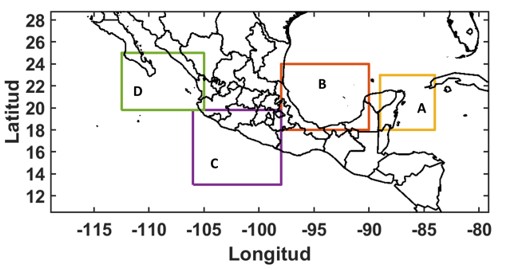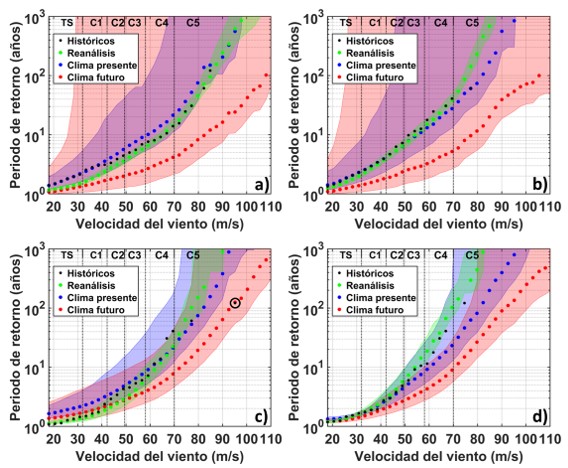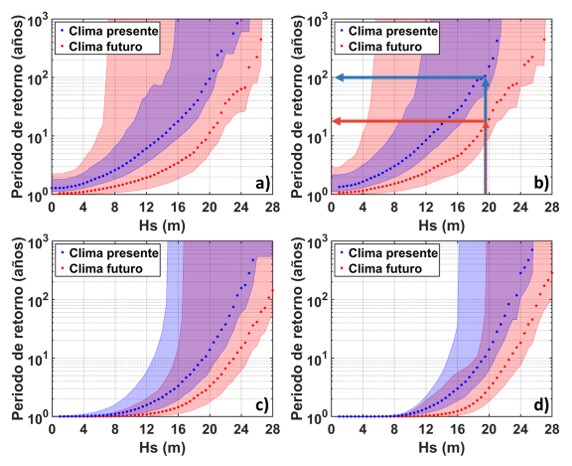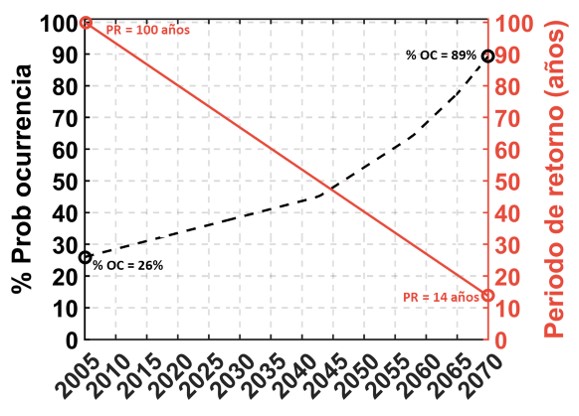31-10-2022
Climate Change and Engineering. Implications for Maritime Structural Design
The latest reports from the United Nations Intergovernmental Panel on Climate Change show that global warming, as a result of anthropogenic activity, has led to an increase of extreme weather events frequency causing severe effects and damages around the world. In this context, the shift to clean energy alternatives and the decrease of energy consumption are essential in order to mitigate greenhouse gas emissions. We must implement adaptation and mitigation measures to deal with present life-threatening events such as droughts, fires, heat waves and floods, among other threats. Recognizing humanity’s impact on the environment, the response involves traditional engineering as well as nature-based solutions. One example is the recovery of coastal lagoons and the mangrove cover aiming at, on the one hand, favoring carbon capture and, on the other, protecting human communities from coastal flooding and other kinds of climate-related risks. These strategies help us adapt to a changing climate and strengthen socio-eco-systemic resilience. Still, there are many situations where traditional engineering is needed as it happens with offshore platforms or port security structures: both kinds of structure should be able to resist nature’s power, in particular, waves strength.Surge is thus one of the main parameters in maritime structures design. It is used to estimate the weight and power that structures must resist, as well as to determine construction materials and size. In the case of Mexico’s seas, tropical hurricanes produce swell in most parts of the country. In this regard, global warming poses a challenge when designing relevant structures since it is expected that higher intensity events will occur in the future (Knutson et al., 2022) producing bigger waves than those we see nowadays (Appendini et al., 2017). Since there are no nature-based platform or breakwater solutions to create calm zones and protect port areas from surge, traditional engineering will continue to be used in their design.
The traditional wave determination method through historical registries should not be used anymore since it does not guarantee a correct characterization of parameters for today’s shifting climate conditions. In the Engineering and Coastal Processes Lab at Sisal Academic Department of UNAM’s Engineering Institute, we carry out studies to assess how climate change will modify tropical storms climatology and hurricane-related waves in order to come up with new methodologies and define design parameters using non-stationary wave climates.
A Synthetic Cyclones Generation Methodology
To study climate change impact on tropical cyclones, we use a methodology based on the numerical generation of synthetic tropical cyclones, as proposed by Emanuel et al. (2008). Its advantages and disadvantages can be found in Emanuel (2021). This methodology helps us to overcome the limitations of reproducing tropical cyclones by means of General Circulation Models (CGMs), a tool usually applied in climate change studies, but which underestimates the frequency and intensity of such phenomena. With this methodology it is possible to generate a large number of tropical cyclones in order to have robust statistics. Synthetic events are driven by tropical cyclones physics through seeding a random number of low-intensity vortices which can either dissipate or continue their evolution into tropical cyclones, depending on ocean and atmospheric conditions obtained from ocean-atmosphere models like climate reanalysis and CGMs. In our study, synthetic events were drawn from reanalysis of the southern part of the Gulf of Mexico and the Mexican Pacific area in order to compare them with past events in climatological terms. In analyzing the effects of climate change, we worked with synthetic events derived from the mesoscale conditions created for six CGMs that considered current climate (1975-2005) and future weather prospects (2070-2100) in the context of greenhouse gas emissions. Emanuel (2021).
Being able to produce a large number of synthetic events with this technique, it is possible to replicate tropical cyclones in areas where there is no historical information. Thanks to this, we can evaluate areas of scarce incidence and expand statistical data. For instance, the historical information needed to carry out flood studies at Dos Bocas refinery area in Tabasco would show that, in a circular area with a 100 kilometers radius around the refinery, just five storms have stricken from 1970 to the present (previous satellite data are not reliable). This little number prevents us from conducting an analysis of extreme values to establish design conditions. However, by means of synthetic events, we can predetermine and create a certain number of events, some of them developing into hurricane categories that could emerge in the area because proper physical conditions would allow it even though probability remains low. Thus, by creating synthetic events, we can obtain strong statistics for the refinery area which would be impossible to get from historical trends.
Then, we compared CGM-derived synthetic events of current climate conditions with reanalysis synthetic events to evaluate their performance. This way we have a valid database to compare CGM synthetic events under current weather conditions, with future events, and so we may use synthetic events to evaluate tropical cyclones affecting the Mexican seas as well as the impact of climate change on them. Figure 1 shows a regionalization of the studied areas in terms of tropical cyclones occurrence and their related surge, including significant port areas both for cargo facilities (the Mexican Pacific coast and the Gulf of Mexico) and/or tourism (Pacific and Caribbean regions), as well as offshore platforms (Gulf of Mexico). Figure 2 contains a probability assessment of return periods for wind speed in both the Mexican Pacific seashore, and the Gulf of Mexico and Caribbean Basin. Climate events’ historical records are represented in black dots; assembly median of reanalysis-derived events in green dots; current climate MGC in blue dots and future climate MGC in red dots. Uncertainty envelope is represented in the corresponding color of each category.
Figure 1. Evaluated areas prone to tropical cyclones

A) Mexican Caribbean sea, B) Gulf of Mexico, C) Southern Central Pacific; Northern Central Pacific.
Elaborated by the authors.
Figure 2. Return period of wind intensity of tropical cyclones

a) Mexican Caribbean, b) Southern Gulf of Mexico, c) Southern Central Pacific, d) Northern Central Pacific.
Elaborated by the authors.
Results show that historically recorded weather events are adequately represented by synthetic events derived from reanalysis while they remain in the uncertainty of CGM-derived events under current climate features, which validate the use of synthetic events. Area D (the northern portion of Mexican Central Pacific) is the exception since the average of CGM-derived events for current climate conditions overestimates what is shown in terms of historical trends and reanalysis. These deviations between CGMs and reanalysis are commonly corrected using bias correction methods. Consequently, we can expect a similar bias in the case of CGM-derived events for future climate conditions, and so, it does not affect the relative change. Yet, it is recommended to carry out bias correction when conducting a design study.Looking at the uncertainty between current and future climate, it is not possible to categorically assure that there will be an increase in the probability of more intense events in the future since the uncertainty envelopes overlap. However, the assemblies median is calculated in order to represent a more likely scenario where the models’ biases are compensated. Thus, we can say that the probability of more intense events taking place in the future will increase since the assemblies average indicates so. It is interesting to note that, in 2015, hurricane Patricia developed in the Southern Mexican Pacific reaching a maximum speed of 95 meters per second (see in figure 2c the black dot highlighted within a circle). It represents one single event in over a 1000 year period at present weather conditions but that period reduces to one 125 years when future climate conditions are considered.
Based on synthetic events characteristics, we proceeded to simulate their wind fields to later produce a wave model and obtain the maximum wave fields corresponding to each event. This information is used in analyzing the characteristics of extreme waves in each region and exploring how wave parameters will be modified for structures design. Figure 3 illustrates the swell return periods in each region, where the assemblies average show again a rise of extreme events probability within the context of climate change. Regarding the 100 year return period commonly used in design, wave height increases approximately 23% in the Gulf of Mexico and the Caribbean and it varies from 14 to 18% in the Mexican Northern and Southern Pacific respectively.
Figure 3. Return period of wave height (Hs) during tropical cyclone

a) Mexican Caribbean, b) Southern Gulf of Mexico, c) Southern Central Pacific; d) Northern Central Pacific.
In figure 3b, arrows show the wave height of 19.2 meters and corresponding return period in current weather conditions (blue) and future climate scenario (red).
Beyond zone of uncertainty (high risk).
Though this increase may not seem very high, let’s think on the fact that if we use the 100 year return period to design an offshore structure in the Gulf of Mexico, the estimated wave will be 19.2 meters high; however, as we get closer to future climate context, the return period of such wave height would then shrink to 14 years (see figure 3b; wave height and return period are indicated with arrows). This means there is a probability increase for the designed waves to actually occur during the useful lifetime of the structures; therefore, they will be damaged and could undergo serious operational consequences. For example, let’s consider a structure conceived to last for a 30 year operation period in the Gulf of Mexico (figure 4), calculated with a wave return period of 100 years. The return period decreases as the future climate scenario approaches, elevating the event’s occurrence probability from 26% in the current climate context (2005) to 89% in the future climate scenario (2070). Such an increase greatly raises the probability that the structure would be damaged or even destroyed (total failure).
Figure 4. Evolution of the occurrence probability of design waves

Beyond zone of uncertainty (high risk).
Based on the previous information, we can argue that the use of synthetic events helps us prepare for the future by giving us the chance to assess tropical cyclones and their consequences in a shifting climate context. In our case, we focus on surges around maritime structures design. The studies can be expanded by taking winds, storm waves and rainfall caused by tropical cyclones in account. In addition to being able to implement our work results in facilities’ design by means of traditional engineering, we could also take advantages of them in developing nature-based solutions, damage and risk studies, management plans and adaptation strategies. It is our hope that this paper will encourage the application of this methodology in other areas so that we will strengthen our resilience in coping with the effects of climate change.
Christian M. Appendini PhD is a senior researcher at the Coastal Processes and Engineering Laboratory, Sisal Academic Unit, Engineering Institute, UNAM.
Pablo Ruiz Salcines PhD, attached to the Coastal Processes and Engineering Laboratory, Sisal Academic Unit, Engineering Institute, UNAM is currently working at the Department of Geography of the Rovira i Virgili University, Tarragona, Spain.
This work is part of the Mexican Center for Energy Innovation-Océano studies (CEMIE-Océano, Spanish initials). The authors wish to thank Ana Ramírez Manguilar, Rafael Meza Padilla, and Gonzalo Uriel Martin Ruiz, for their collaboration in different stages of the study.
English version by Zoraida Pérez.
References
Appendini, C. M; Pedrozo-Acuña, A.; Meza-Padilla, R.; Torres-Freyermuth, A.; Cerezo-Mota, R.; López-González, J., y Ruiz-Salcines, P. (2017). “On the Role of Climate Change on Wind Waves Generated by Tropical Cyclones in the Gulf of Mexico”. Coastal Engineering Journal 59 (https://doi.org/10.1142/S0578563417400010).
Emanuel, K. (2021). “Response of Global Tropical Cyclone Activity to Increasing CO2: Results from Downscaling CMIP6 Models”. Journal of Climate, 34(1), pp. 57-70 (https://doi.org/10.1175/JCLI-D-20-0367.1).
Emanuel, K.; Sundararajan, R., y Williams, J. (2008). “Hurricanes and Global Warming: Results from Downscaling IPCC AR4 Simulations”. Bulletin of the American Meteorological Society, 89(3), pp. 347-367 (https://doi.org/10.1175/BAMS-89-3-347).
Knutson, T.; Camargo, S. J.; Chan, J. C. L.; Emanuel, K.; Ho, C.-H.; Kossin, J.; Mohapatra, M.; … Wu, L. (2020). “Tropical Cyclones and Climate Change Assessment: Part II: Projected Response to Anthropogenic Warming”. Bulletin of the American Meteorological Society, 101(3), E303-E322 (https://doi.org/10.1175/BAMS-D-18-0194.1).
Pablo Ruiz Salcines PhD, attached to the Coastal Processes and Engineering Laboratory, Sisal Academic Unit, Engineering Institute, UNAM is currently working at the Department of Geography of the Rovira i Virgili University, Tarragona, Spain.
This work is part of the Mexican Center for Energy Innovation-Océano studies (CEMIE-Océano, Spanish initials). The authors wish to thank Ana Ramírez Manguilar, Rafael Meza Padilla, and Gonzalo Uriel Martin Ruiz, for their collaboration in different stages of the study.
English version by Zoraida Pérez.
References
Appendini, C. M; Pedrozo-Acuña, A.; Meza-Padilla, R.; Torres-Freyermuth, A.; Cerezo-Mota, R.; López-González, J., y Ruiz-Salcines, P. (2017). “On the Role of Climate Change on Wind Waves Generated by Tropical Cyclones in the Gulf of Mexico”. Coastal Engineering Journal 59 (https://doi.org/10.1142/S0578563417400010).
Emanuel, K. (2021). “Response of Global Tropical Cyclone Activity to Increasing CO2: Results from Downscaling CMIP6 Models”. Journal of Climate, 34(1), pp. 57-70 (https://doi.org/10.1175/JCLI-D-20-0367.1).
Emanuel, K.; Sundararajan, R., y Williams, J. (2008). “Hurricanes and Global Warming: Results from Downscaling IPCC AR4 Simulations”. Bulletin of the American Meteorological Society, 89(3), pp. 347-367 (https://doi.org/10.1175/BAMS-89-3-347).
Knutson, T.; Camargo, S. J.; Chan, J. C. L.; Emanuel, K.; Ho, C.-H.; Kossin, J.; Mohapatra, M.; … Wu, L. (2020). “Tropical Cyclones and Climate Change Assessment: Part II: Projected Response to Anthropogenic Warming”. Bulletin of the American Meteorological Society, 101(3), E303-E322 (https://doi.org/10.1175/BAMS-D-18-0194.1).
